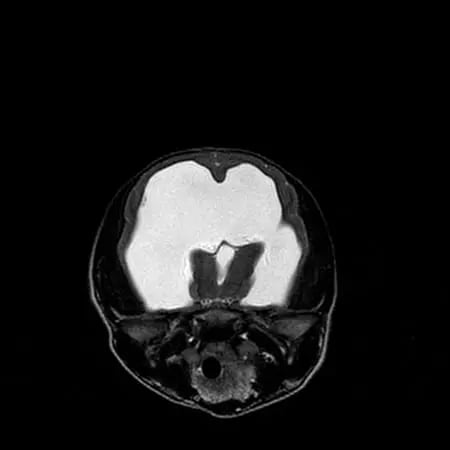Bernie
Hydrocephalus
Home » Case Studies » Bernie

History

Bernie, a 3-month-old intact male Terrier mix, presented to Southeast Veterinary Neurology (SEVN) for weakness in all four limbs and walking in circles.
Although Bernie’s complete history is unknown, he was rescued from the county shelter as unable to walk and mentally dull. He was taken to an animal hospital, where he stayed for five days on IV fluids and several medications, until it was recommended that he be evaluated by a neurologist and brought to SEVN.
Examination
Upon examination, Bernie was quiet and noted to have a dome-shaped skull. He displayed ambulatory tetraparesis (able to walk, but weakness in all four limbs) with a strong tendency to turn and circle to the left.
Cranial nerve assessment revealed divergent lateral strabismus (abnormal position of the eyes, turning away from the nose), spontaneous horizontal nystagmus with fast phase to the left (abnormal movement of the eyes, darting to the left), and absent menace response (blinking in response to the rapid approach of an object) in both eyes, as well as absent nasal sensation on the right side.
Lastly, postural reactions (responses that help maintain a normal, upright position) were absent in both limbs on the right side.
Based on the examination findings, Bernie’s neuroanatomical localization was multifocal (affecting more than one part of the brain). Likely causes included congenital malformation, infection, or trauma.

T2-weighted axial “cross section” MRI image of Bernie’s brain. The large white areas are his lateral ventricles, which are the large fluid filled accumulations within his brain, which is the lighter gray area around the fluid pockets.
Labs & Imaging

T2-weighted axial “cross section” MRI image of Bernie’s brain. The large white areas are his lateral ventricles, which are the large fluid filled accumulations within his brain, which is the lighter gray area around the fluid pockets.
A CBC (complete blood count) and chemistry panel done prior to presentation were unremarkable.
High-field MRI of Bernie’s brain was performed in multiple planes and sequences to expose dramatic hydrocephalus. Generally speaking, hydrocephalus is due to either obstruction of the flow of cerebrospinal fluid (CSF) or accumulation of CSF in spaces where brain tissue should be. Bernie’s MRI seemed to show some characteristics of each.
Medical Treatment
Bernie was prescribed prednisone and omeprazole to help decrease fluid buildup within the brain.
He seemed to improve for a couple of weeks until he was weaned off the prednisone, at which point his behavior changed. Bernie began snapping his teeth at the air and becoming agitated when handled. His prednisone was increased, but a few days later, he began running into walls and screaming when touched. When he returned to SEVN for emergency evaluation, he was acutely obtunded (dull mentation), and proprioception (awareness of body position and movement) was absent in all four limbs. He was laterally recumbent (lying on his side) with a mild fever.
Bernie was hospitalized with IV fluids while his medications were adjusted, including the resumption of prednisone. Because dogs with congenital malformations like hydrocephalus can have other congenital conditions, a bile acids test was also administered to screen for a liver shunt, but it came back normal.
Bernie improved in the hospital, becoming stable, ambulatory (able to walk), and nonfebrile (without fever). A subsequent recheck exam showed subtle progress, but he did not improve as much as he did initially.

Surgical Treatment

Considerable risks and potential complications are associated with surgery. However, out of concern that Bernie would not achieve a reasonable quality of life through medical management alone, he underwent surgical treatment of hydrocephalus. During the procedure, a ventriculoperitoneal (VP) shunt was placed to redirect fluid from the brain into the abdomen. Surgery went well, without any complications, and by the time he was discharged, Bernie had made dramatic improvements in behavior and mobility.
At his two-week recheck, Bernie was alert and strongly ambulatory, with only mild generalized ataxia (unsteady gait) and thoracic limb hypermetria (high stepping of his front limbs). He lacks visual responses, but is suspected to retain some vision, as he navigates new spaces well. However, to avoid injury, he should be kept safely enclosed, off of furniture, and away from stairs, pools, canals, etc. when not directly supervised. Bernie will taper off prednisone, but will remain on omeprazole for life, and gabapentin may continue to be used as a sleep aid.
Bernie has continued to improve. He is now playing, he’s more able to interact and engage with people and the environment, and he’s become amenable to handling. Overall, he appears to be recovering very well from surgery. Although complete recovery is not always achieved, Bernie’s tremendous improvements have provided him with a good quality of life, and he has since been adopted!

Takeaway

It’s critical to address hydrocephalus at the first signs to prevent brain damage and have the best chance of recovery. Medical treatment can manage symptoms, including seizures, brain inflammation, and fluid buildup in some cases. However, drug therapies often only provide a temporary solution. More definitive treatment involves the surgical placement of a shunt that redirects CSF from the brain to the abdomen, where it can be reabsorbed. Unfortunately, because the procedure is expensive and requires a highly specialized neurosurgeon, most dogs never receive it. Bernie was lucky to have ended up in expert hands at Southeast Veterinary Neurology.